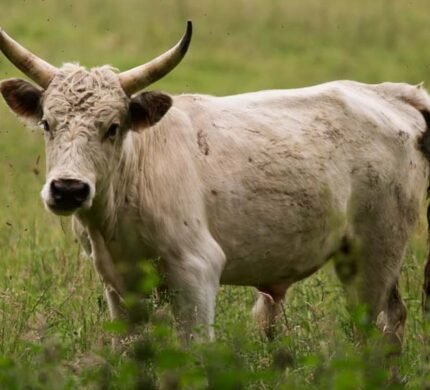Chillingham Cattle
- Temperature:Cold and wet
- Milk:Less milk produce
- Food:Variety of grasses, Herbs and Plants
- Pregnancy:Approximately 280 days
- Nationality:Northumberland, England

General Information
Chillingham cattle are a rare breed of wild cattle that are native to the Chillingham Park in Northumberland, England. They are a unique breed that has been present in the park for centuries and are thought to be descendants of wild cattle that once roamed the forests of Britain.
They are known for their hardiness and ability to survive in harsh weather conditions. Despite being a rare and unique breed, they have adapted well to their natural environment and are able to thrive in the cold, wet climate of Northumberland.
These cattle are relatively small in size, with cows typically weighing between 400-500 kg (880-1100 lbs) and bulls weighing between 500-600 kg (1100-1320 lbs). They have a distinctive appearance, with a white or creamy-colored coat and long, curved horns.
Where we find this cow to buy?
Chillingham cattle are a rare breed of cattle, with a population estimated to be less than 150 in the world. As such, it may be difficult to find Chillingham cattle for sale.
Chillingham cattle are a rare and endangered breed, with only a small population remaining in the world. They are primarily kept for conservation purposes and as a tourist attraction in the Chillingham Park in Northumberland, England, where they are managed by the Chillingham Wild Cattle Association.
Due to their rarity and conservation status, it is generally not possible to purchase Chillingham cattle for commercial or agricultural purposes. The Chillingham Wild Cattle Association carefully manages the breeding and population of Chillingham cattle to ensure their long-term survival, and the cattle are not sold for meat or other commercial uses.

How to increase milk production in Chillingham Cattle
Chillingham cattle are a rare breed of cattle that are primarily kept for conservation and as a tourist attraction, rather than for commercial milk production. However, there are still some general practices that can help increase milk production in cattle:
01
Providing cattle with good quality forage and high-quality concentrate feed can help increase milk production.
02
Cows should have access to clean water, adequate space, and good ventilation for good milk production.
03
Regular veterinary care is essential for the health of cows, as it can help identify and treat any health issues that may affect milk production.
04
Breeding cattle with good milk production genetics can help improve milk yield in future generations.
Medicine
Some common medicines that may be used to treat Chillingham cattle, like all cattle, include:
01
AntibioticsAntibiotics are used to treat bacterial infections in Chillingham cattle, such as penicillin, tetracycline, and sulfonamides.
02
Anti-inflammatory drugsAnti-inflammatory drugs such as (NSAIDs) may be used to treat pain and inflammation in Chillingham cattle.
03
VaccinesVaccines are used to protect Chillingham cattle from various diseases, such as bovine rhinotracheitis, bovine viral diarrhea, and leptospirosis.
04
AnthelminticsAnthelmintics are used to treat and prevent internal parasites in Chillingham cattle.
Pregnancy
Cattle can be bred naturally or through artificial insemination. The optimal time for breeding is usually determined by monitoring the cow’s estrus cycle, which lasts approximately 21 days.
Cattle typically give birth to a single calf, but twins can occur. It is important to provide a clean and comfortable environment and monitor the calf closely after birth to ensure it is healthy and nursing properly.
Pregnant Chillingham cattle require a balanced and nutritious diet that provides the necessary nutrients for both the cow and the developing calf. This may include good quality forage, a high-quality concentrate feed, and mineral supplements.
Regular veterinary care is essential during pregnancy to monitor the health of the cow and the developing calf. This may include regular check-ups, ultrasound examinations, and vaccinations as recommended by the veterinarian.
Important!
It is important to note that the specific needs and requirements of pregnant Chillingham cattle may vary depending on various factors, including the individual animal’s health, age, and reproductive history. Consultation with a veterinarian is recommended to ensure proper care during pregnancy.
Food
The specific diet of Chillingham cattle may vary depending on their age, reproductive status, and level of activity. Here are some general guidelines for feeding Chillingham cattle:
They are grazers and are well-suited to eating high-quality forage, such as grass and hay. Providing access to good quality pasture or hay is important to ensure their nutritional needs are met.
In addition to forage, Chillingham cattle may be fed a concentrate feed that is high in protein and energy. The amount and type of concentrate feed will depend on the animal’s age, reproductive status, level of activity.
They need mineral supplements to ensure they are getting the necessary nutrients for bone development and overall health.
Access to clean water is essential for the health of Chillingham cattle. Provide fresh and clean water at all times.
Facts
Chillingham cattle are a rare and unique breed of cattle that have been bred in the Chillingham Park in Northumberland, England for several hundred years. Here are some interesting facts about Chillingham cattle:
Chillingham cattle are believed to be one of the oldest breeds of cattle in Britain, with a history that dates back to the 13th century.
Chillingham cattle are a rare breed and are considered a conservation priority, with only 150 in the world today.
Chillingham cattle are known for their hardiness and ability to survive in harsh environments, making them suitable for living outdoors year-round.
Chillingham cattle are a small breed of cattle, with cows weighing approximately 500-600 pounds and bulls weighing up to 1,000 pounds.
Chillingham cattle have a distinctive white coat, which helps them blend in with the snowy landscape of their natural habitat.
Chillingham cattle are one of the few remaining purebred breeds of cattle in the world, having been genetically isolated for centuries.
Chillingham cattle have a generally docile temperament and are known for their calm and gentle nature.
Chillingham cattle are a popular tourist attraction in the Chillingham Park, where visitors can see them in their natural habitat.